A local solution to a global problem
Helping fish find their way in Lao PDR
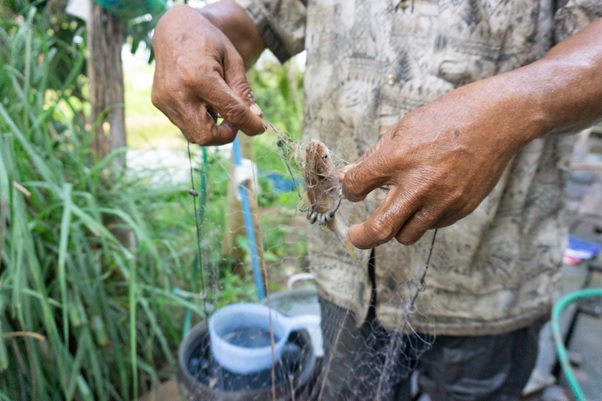
Getting fish out of the net in Pak Peung village
In Lao PDR, ACIAR (Australian Centre for International Agricultural Research) is developing a locally designed fish passage to rehabilitate the Mekong fish species’ migration into side streams and wetlands. And while it is a local problem with local implications, the project’s results reaches far beyond the small fishermen village where it all began. It is early morning, the sun has just come out over the rice fields and Thongkoun Phimmavong is taking his wooden canoe to go fishing. He brings a metal tray and a blue net, puts on his hat and says a few goodbye words to his wife. He walks to the stream next to his and his wife’s small farm house. A few hundred meters away east runs the Mekong river. Thongkoun lives in Pak Peung village in the southern Laos province of Borlikhamxay. The stream he fishes in every morning is part of the Mekong upstream wetlands that are vital for Mekong fish species to reproduce. This is where the fish goes to breed and nurse. Fish is the single most important protein source for the Lao people. Thongkoun has the same routine every morning for more than forty years now. Though before, he used to fish in the Mekong river with a net. But now, with 67 years and all six children out of the house, he only goes fishing in the Mekong side streams. Here he has three nets that he attends to every morning. On a good day, he catches around ten kilos from the fish traps. His wife takes the fish to the nearby market in Pak Peung village and sells it to other villagers. On less lucky days, he only catches about 2 kilos which is only enough for their own food. This morning, he sets out to empty the fish nets to come home with fish for breakfast. The wooden canoe glides smoothly through the muddy water of the side stream. A few other fishermen are checking their nets in the stream as Thongkoun passes by. In the forty years Thongkoun has been fishing, he has seen dramatic changes in his daily fish catch: ‘The amount of fish that I catch has decreased a lot compared to forty years ago. When there was no irrigation structure at the river yet, we would catch up to 120 kilos in one batch,’ he says.
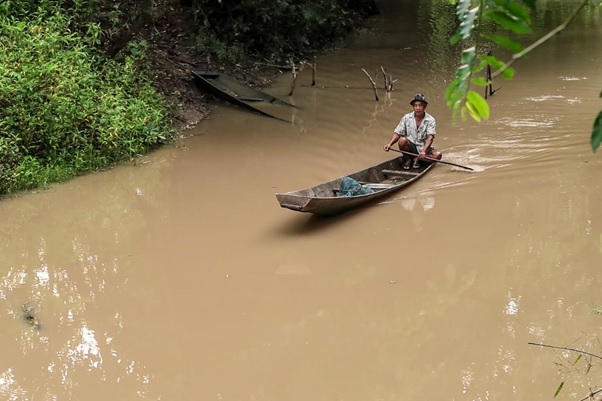
Mr. Thongkoun Phimmavong starting his morning routine by fishing in a Mekong side stream
Water control devices - such as weirs and flood control gates - are now an integral part of the Mekong river system. Throughout the past 50 years, rice irrigation systems have increasingly been build in Lao PDR to secure the country’s rice production. While good for the rice farmers, who are suffering from drought and irregular rain, it is bad for the Mekong fish species. The fish goes to the upstream wetlands to mate and breed, and the wetlands are also important nurseries for smaller fish. Freshwater fish from the Mekong river and other side streams provide approximately fifty percent of the animal protein consumed in Lao PDR. The average Lao citizen eats more than twenty five kilo of fish every year. Despite being landlocked between other Southeast Asia countries, fish is the biggest source of protein for the Lao people, exceeding beef, chicken or pork by far, because of the fisheries along the Mekong river.
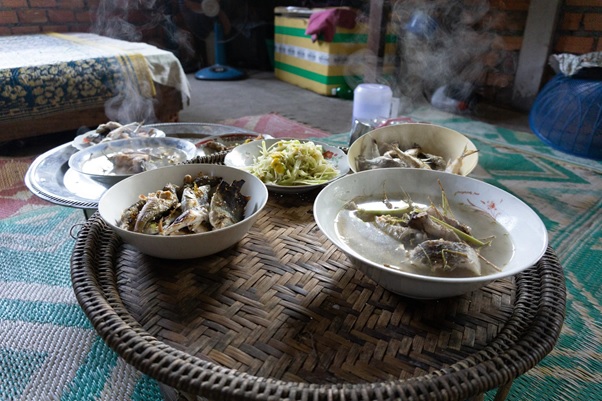
Fish as an important source of protein for people in Lao PDR
Lee Baumgartner, project leader from the Institute for Land, Water and Society at Charles Sturt University, explains: ‘Wetland flood productivity in Lao PDR is very important, because it is a nursery for fish. What has happened is that flood plains have been developed for rice production, which resulted in blocking the fish. Unfortunately the increasing rice production has caused a decrease in fish production. Our project focuses on sustainable fisheries, so local people can have this source of protein and nutrition.’ The problem of infrastructures on rivers blocking fish’ migration is not only a problem in Lao PDR. From Norway to Germany, from Myanmar to Australia, fish passages have been constructed in order to allow fish to migrate. However, the ACIAR funded project is unique in the sense that it involves local villagers in both research and construction as well as management of the fish passage. The fish passage in Pak Peung was designed and build with a participatory approach, including men and women from Pak Peung. Nowadays the fish passage is solely managed and maintained by villagers, and the research of the biodiversity in the wetlands is also carried out by locals. For Lee, it is about taking lessons learned on fish ways in Australia and applying them in the local Lao PDR context. ‘Fish passages have been very successfully applied in Australia in the past 20 years. Our project is all about taking the technology which was developed there and refining it for specific application in the lower Mekong region. There are very big differences between the fish in Australia and the fish in Lao PDR. Our research taught us all about the local fish, in order to provide local solutions. We then developed a fish ladder that was specifically targeted towards Mekong fish.’ he explains. The process took about five years and started with a small wooden structure. Now it is a fully designed fish way, permanent rehabilitating the wetland in Pak Peung village.
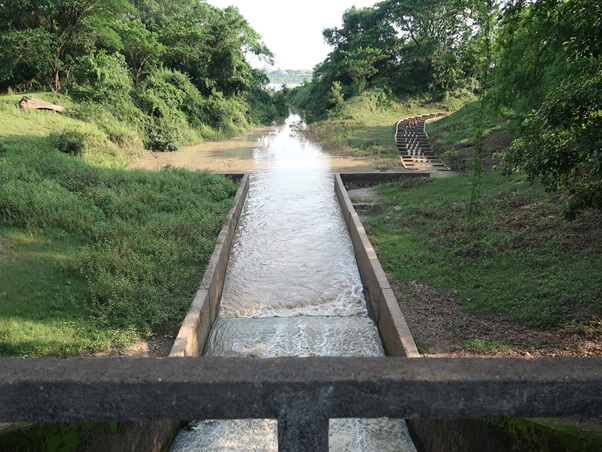
The permanent fish ladder in Pak Peung village
Once the fishways demonstrated to be successful in the Mekong wetlands, Lee and the project team reached out to other partners to work on sustainable fisheries on a larger scale. This has resulted in substantial interest from donor bodies such as the World Bank and the Asian Development Bank, who are seeking guidance to ensure their irrigation programs are fish friendly. The fish ladder in the small village Pak Peung is now serving as a demonstration site for a local solution to a global problem. ‘The demonstration site is providing an evidence-based education tool, where people from Laos and abroad can come and see the ecological, social and institutional benefits of fishways. This is a really important site for providing solutions to the problem of damaged fish migration, which is indeed a problem all over the world,’ says Lee.
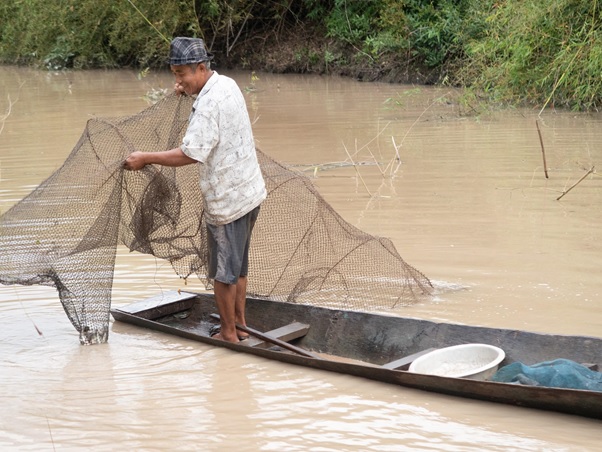
Thongkoun Phimmavong with the catch of the day
Thongkoun empties the last net for the morning with a content look on his face. The catch is big. The metal tray is filled with Mekong fish of different sizes and species. “In the last ten years, I saw the fish almost disappearing. After the fish passage was built, I am starting to catch more fish again,” says Thongkoun before he turned his wooden canoe around and head to his wife with his catch of the day. This morning there will be fish for breakfast.
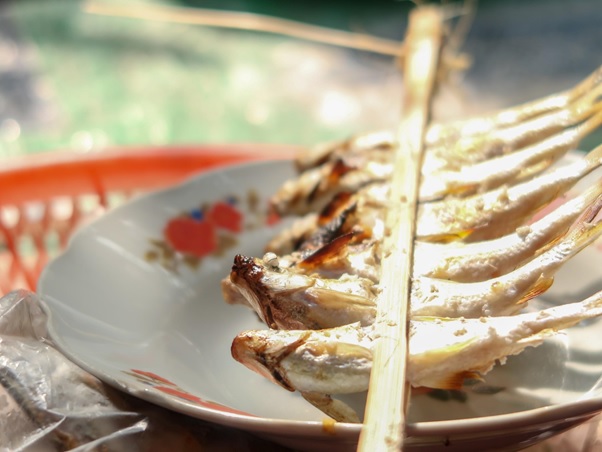
Grilled fish from the cook stove at Phimmavong’s house
